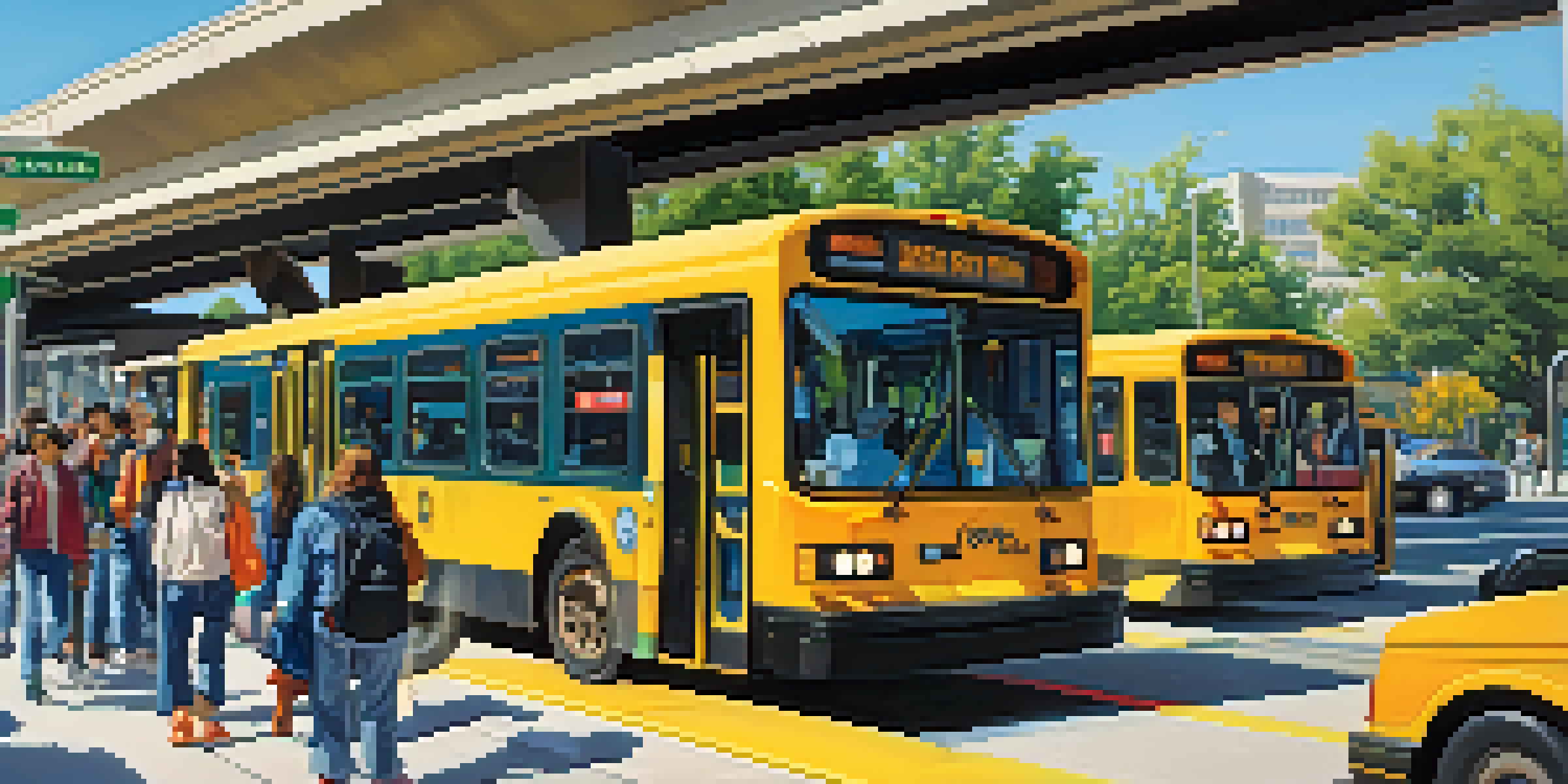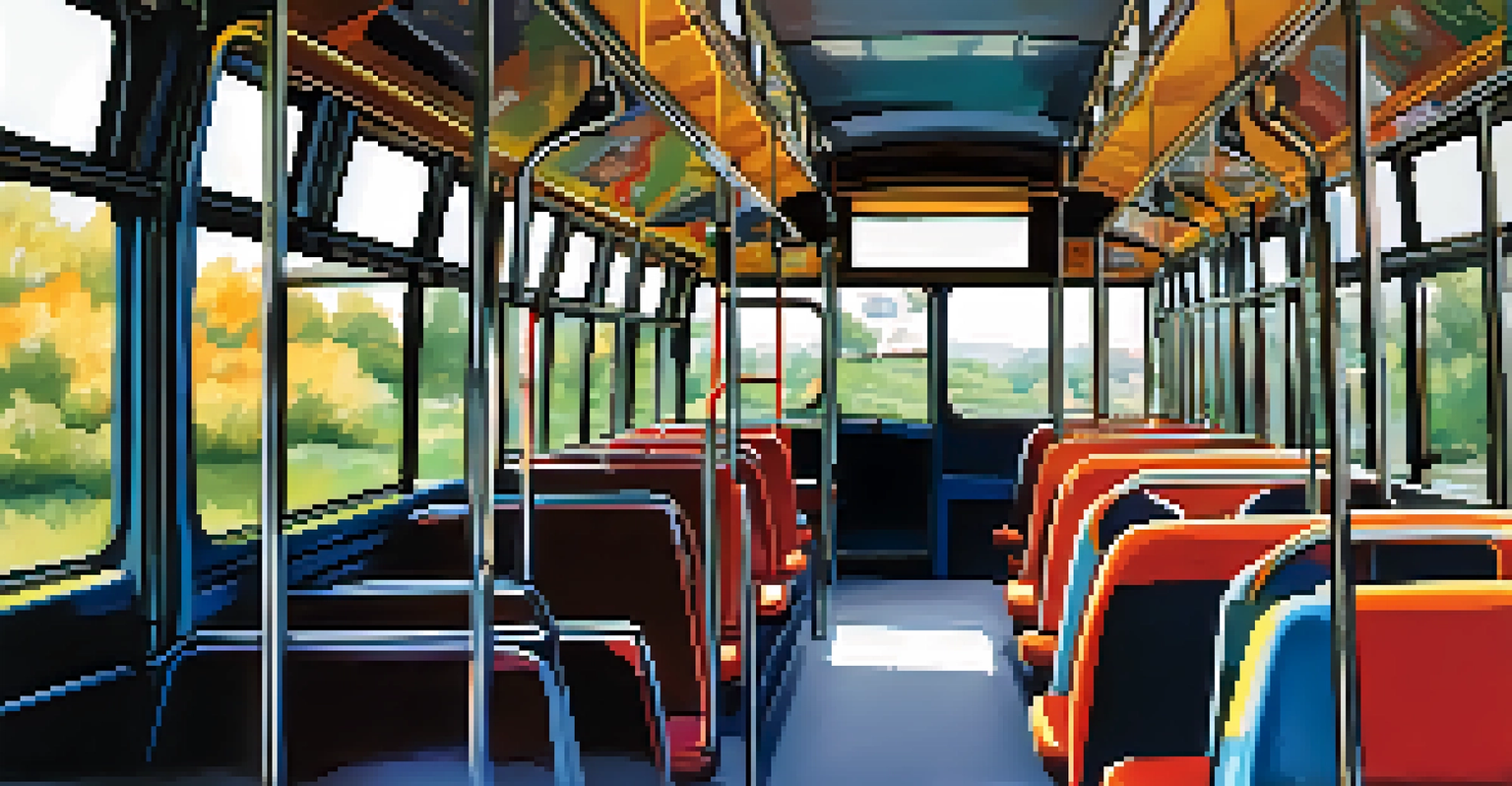Public Transit Accessibility: San Jose's Commitment to All

Understanding Public Transit Accessibility in San Jose
Public transit accessibility refers to the ease with which all individuals, including those with disabilities, can use transportation services. In San Jose, this concept is integral to creating an inclusive environment. By focusing on features like ramps, designated seating, and audio-visual aids, the city aims to ensure that public transportation is available to everyone.
Public transit is a lifeline for individuals with disabilities, providing them with the freedom to explore and participate in their communities.
San Jose’s public transit system not only supports individuals with mobility challenges but also caters to seniors and families with young children. The goal is to eliminate barriers that can prevent people from accessing essential services or enjoying community events. This commitment reflects a broader understanding of the diverse needs within the community.
Moreover, accessibility isn't just about physical structures; it also encompasses user-friendly information systems. By providing clear schedules, maps, and real-time updates, San Jose is working to empower all residents to navigate the transit system confidently.
Key Features of San Jose's Accessible Transit System
San Jose’s transit system includes various features designed to enhance accessibility. These include low-floor buses that allow easier boarding, as well as tactile guide paths at stations. Such features are vital in ensuring that individuals with mobility impairments can travel without unnecessary stress.

Additionally, the city has implemented audio announcements on buses and trains, which assist visually impaired passengers. When these announcements are synchronized with visual displays, they create a supportive environment for all riders. This thoughtful integration of technology and design speaks volumes about San Jose’s dedication to inclusivity.
Inclusive Transit for All Residents
San Jose's public transit system focuses on features like ramps and audio-visual aids to ensure accessibility for individuals with disabilities, seniors, and families.
Furthermore, accessible transit stops with proper signage and seating areas make waiting for public transport more comfortable for everyone. These enhancements go a long way in fostering a sense of belonging and community for all San Jose residents.
Community Engagement in Transit Planning
San Jose recognizes that effective public transit planning requires input from the community, especially those who will use the services. Engaging individuals with disabilities and advocacy groups helps identify specific needs and challenges. This collaborative approach ensures that the transit system is not only accessible but also tailored to the community's unique demographics.
Accessibility is not a privilege. It is a right for everyone, and it’s essential for a thriving community.
Regular public forums and surveys are part of this engagement strategy, allowing residents to voice their opinions and suggestions. By actively listening to the community, San Jose can make informed decisions that truly reflect the needs of its diverse population. This open dialogue fosters trust and transparency between the city and its residents.
Ultimately, community engagement leads to better outcomes and more effective transit solutions. When people feel heard and valued, they are more likely to use public transit options, further enhancing the system's success and sustainability.
Funding and Resources for Accessibility Initiatives
To make these ambitious accessibility goals a reality, San Jose allocates funding specifically for transit enhancements. This financial commitment is crucial for implementing new technologies and upgrading existing infrastructure. Through both federal and state grants, the city can invest in projects that prioritize accessibility.
In addition to public funding, partnerships with local organizations and advocacy groups play a key role. These collaborations not only provide additional resources but also bring valuable insights to the planning process. By working together, San Jose can leverage a variety of expertise to improve public transit services.
Community Involvement in Planning
Engaging the community, especially those with disabilities, is crucial for tailoring San Jose's transit system to meet the unique needs of its diverse population.
Moreover, transparency in how funds are utilized reassures the community that their needs are being prioritized. Regular updates on project milestones help maintain public interest and support for ongoing accessibility initiatives.
Innovative Technologies Enhancing Transit Accessibility
In the digital age, technology plays a pivotal role in enhancing public transit accessibility. San Jose has introduced mobile apps that provide real-time tracking of buses and trains, which is a game changer for users. Such innovations help individuals better plan their journeys and reduce wait times, increasing the likelihood of using public transportation.
Moreover, features like text alerts and easy-to-read digital displays at transit stops ensure that information is accessible to everyone. These tools not only benefit those with disabilities but also enhance the overall experience for all passengers. By embracing technology, San Jose is setting a standard for modern, accessible public transit.
As these technologies evolve, there's potential for even greater advancements in accessibility. For instance, integrating artificial intelligence could lead to personalized transit recommendations based on user needs, making travel even more seamless for all.
The Impact of Accessible Public Transit on Communities
Accessible public transit has far-reaching benefits beyond simply enabling travel. It fosters social inclusion by connecting individuals with jobs, education, and recreational activities. For many residents of San Jose, reliable transit can significantly enhance their quality of life, opening doors to opportunities that may have previously felt out of reach.
Furthermore, when public transit is accessible, it encourages more people to use these services instead of relying on personal vehicles. This can lead to reduced traffic congestion and lower emissions, contributing to a healthier environment. San Jose’s commitment to accessibility thus aligns with broader sustainability goals for the city.
Future Goals for Enhanced Accessibility
San Jose aims to continually upgrade transit infrastructure and staff training to exceed accessibility standards and promote a more inclusive environment.
Ultimately, an accessible transit system strengthens community ties. When everyone has the means to participate in local events and services, it fosters a sense of belonging and enhances community spirit.
Looking Ahead: Future Goals for Transit Accessibility
San Jose's journey towards complete public transit accessibility is ongoing, and future goals are ambitious yet achievable. The city aims to continue upgrading infrastructure, ensuring that all transit options are not only compliant with accessibility standards but exceed them. This commitment reflects a forward-thinking approach to urban planning.
In addition, San Jose plans to expand training programs for transit staff, ensuring they are equipped to assist passengers with diverse needs. This human element is crucial; knowledgeable and compassionate employees can make a significant difference in the travel experience for those who require assistance.

Finally, the city envisions a comprehensive assessment strategy to evaluate the effectiveness of existing accessibility measures. By continually monitoring progress and making adjustments, San Jose will remain a leader in public transit accessibility, setting an example for other cities to follow.